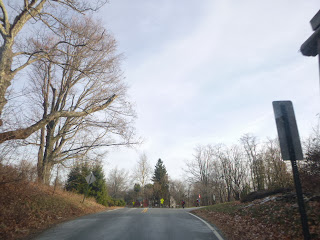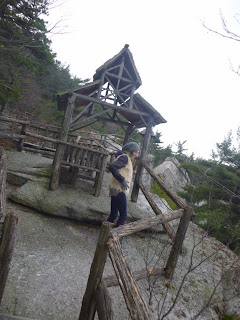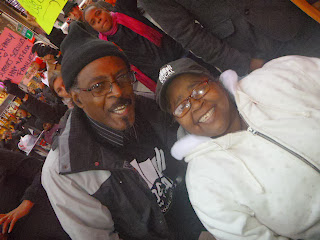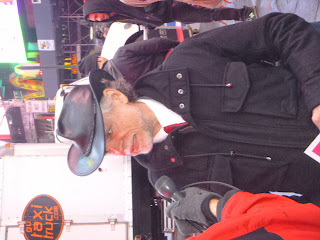For
years there, I used to go up to our syringe exchange program in the Bronx for
Thanksgiving. Only a few members of the
program tended to show up. But those who
did made the day special. We watched
football, hung out, talked, but mostly, we just kept each other company,
enjoying a few brief moments together in time.
Afterward,
I’d go visit the More Gardens house or garden and then go home for the meal.
Since
leaving AIDS Inc., I’ve connected with those at risk, as part of New
Alternatives or dropped by to read names and support Housing
Works/ACT UP demos. The World AIDS Day actions always mark a
beginning and an end in a cycle of the year, opening up the door to separate and
remind us of what has been of this catastrophe and what a glorious, quirky, and
caring coalition of thoughtful, determined people can do to move it in new
directions. Over the years, its ebbed and
flowed part of global justice, anti
homeless, Occupy-inspired, queer or multi-issue movements. At its best, this activism is a bit of all of
these things.
These thoughts were with me as World AIDS Day overlapped with
Thanksgiving and Hanukah last weekend.
Every year is different, but World AIDS Day has always meant spending
time with Housing Works, ACT UP, and other AIDS activists in New York.
These are days are spent reading names and remembering those lost to the onslaught or still coping with the multiple
crises of HIV, including criminalization, struggles for housing, against
poverty, homeless, and other cruelties of our post-welfare neoliberal city. With the Supplemental Nutrition Assistance
Program cuts, the holes in our dwindling social safety net always seem to be expanding.
These are realities are invisible to so
many. Yet, AIDS activists are still
here to remind us of these challenges, to break the silences which allow this
thing to go rampant.
 |
| Majority Action at ACT UP. |
 |
| The Housing Works crew on World AIDS Day 1999, back when Chris Quinn was a friend. The late great Keith Cylar with a hat on. |
 |
AIDS is not History die in at the NYPL this fall. |
 ACT UP builds on and propels so many movements. This is the first pre act up die-in photo I've ever seen. I'm sure there were others. Post them below if you find them. |
| How the Dutch got their cycle paths. A mass die-in outside the Amsterdam’s Rijksmuseum in the 70's. pic.twitter.com/hjbkFTjHIz |
 |
| BS by Peter Shapiro after NYPD Die-In. |
It is a
part the trip of my life - a driving force.
There
are so many stories and trips we join. Before Thanksgiving, we drove up to Garrison
to hang with the family. On the way, we
talked about another symptom of our broken neoliberal urbanism, library closures. My sister and law makes documentaries. Film after film, she depends on these resources. They give her and others in the creative
industries archives and resources for digging for leads not found on the
internet. Here, she finds leads, answers,
connecting dots, clues, meandering through footnotes, and boxes of notes, as
well as book after book on the stacks. This
only supports the cultural capital which drives the artistic forces, the writing,
movies and stories of this city. Yet
today, the Library
Lovers note: “NYPL wants to sell off
the Mid-Manhattan Library, one of the country's busiest and most popular
library branches? A luxury tower would go up where these books once lived.”
Library supporters will rally on
December 9th at Noon.
Books Not Billionaires
Flash Mob to Save NYPL
Monday, December 9 at 12:00 noon sharp
Steps of the 42nd Street Library
Sponsored by Library Lovers League
* Be ready to take part in theatrical improvisation as the plutocrats try
to displace the books, and the books alternately lament their fate and
seek to stand their ground. Everyone is invited to come in costume as a
favorite book! RSVP on Facebook: http://www.tinyurl.com/SaveNYPL Like on
Facebook http://www.facebook.com/LibraryLoversLeague Follow on Twitter
@LibraryLoversNY
Flash Mob to Save NYPL
Monday, December 9 at 12:00 noon sharp
Steps of the 42nd Street Library
Sponsored by Library Lovers League
* Be ready to take part in theatrical improvisation as the plutocrats try
to displace the books, and the books alternately lament their fate and
seek to stand their ground. Everyone is invited to come in costume as a
favorite book! RSVP on Facebook: http://www.tinyurl.com/SaveNYPL Like on
Facebook http://www.facebook.com/LibraryLoversLeague Follow on Twitter
@LibraryLoversNY
We talked about books and movies
the whole trip. This and other screams and
fun were part of the journey to Bear Mountain.
We enjoyed some food, stories from grandpa, and
friends. The kids table is always the
most fun.
And I
drove up to High Falls to hang with my buddy Jay, spending the afternoon
chatting about the politics of friendship, HIV, and the ways we seem to have
learned so little from the lessons of HIV.
Faced with a politics of shame, politicians cowering in between scandals,
ever expanding HIV rates, attacks on reproductive autonomy, the chances of
changing a cultural conversation around sex remain limited. But they need not. Still, instead of embracing
the notion of a sexual commonwealth, over and over we turn back to a politics of
prudery. Instead of a frank conversation
about sex, pleasure, and prevention, we turn back to shame inducing scolding.
 |
| Body Counts - Sean Strub's remarkable memoir. Remembering is never easy. But doing so helps us all. It helps activism. It helps the culture. |
Yet, there are ways out of the dead ends of moralism. Sean Strub’s lovely new memoir, Body Counts opens up a conversation about a new way of historicizing and moving beyond the politics of shame, HIV criminalization, and panic. (Review forthcoming).
 |
| BS hiking and visiting. Photo by Jay Blotcher. |
In a
nod to our moment which made my day, Jay later posted:
A great stroll through High Falls
yesterday with my pal, academic-activist Benjamin Heim Shepard, discussing the
AIDS epidemic and the healing powers of friendship and (safe) sex in the early
days of the crisis. What happened to that solidarity that thrived under fire? — with Benjamin Heim
Shepard in High Falls,
NY.
The
next morning, the whole crew and I would drive back to New Paltz, stopping in
Rosendale, before making our way up to the Mohonk. Jay first showed me this gorgeous little town
last year at our How to Survive a Plague viewing and panel at the Rosendale Theater. I didn’t have time to stroll last year. This year, we made time, grabbing a Guinness,
rummaging through the treasures, tchotchkes, ephemera, used records, and pop
relics of among the head shops, thrift stores, and yard sales.
Arriving
the gals usually want to skate and swim, sprint through the halls and hang with
Grandmom.
Yet,
there is something in between all these feelings. It’s a quieter place to remember, feel and be.
Going
to bed, we read a few chapters from To Kill a Mockingbird. The iconic lawyer Atticus takes on the case to
defend Tom, a black man facing the uncertainties of the Jim Crow model of
justice of the 1930's US South 1930’s.
This is the world my Mom grew up in in Columbus Ga during the
depression. But the ways the story moves,
small minded townsfolk complaining about Atticus’ efforts, reminds us the system
which we have today. Unable to find
justice for Trevon Martin, the system continues to support forms of xenophobia
small and wide. But it also reminds us
there are those with conscience.
“If you shouldn’t be defendin’ him,
then why are you doin’ it?”
“For a number of reasons,” said
Atticus. “The main one is, if I didn’t I couldn’t hold up my head in town, I
couldn’t represent this county in the legislature, I couldn’t even tell you or
Jem to do something again.”
“You mean if you didn’t defend that
man, Jem and me wouldn’t have to mind you any more?”
“That’s about right.”
“Why?”
“Because I could never ask you to
mind me again. Scout, simply by the nature of the work, every lawyer gets at
least one case in his lifetime that affects him personally. This one’s mine.”
Waking up Sunday, it was World AIDS Day. Posting the World AIDS Day flyer on facebook, my thoughts were about hunger and friendship, comrades past - some here, many gone. Miles and years later, I can’t shake their faces, their lives from my mind.
Still, we woke for breakfast and would enjoy our morning hiking and skating, but the afternoon would have to include the afternoon rally. It had to.
And back to Times Square
intersection of the world for the afternoon.
Instead of downtown, voices shook through the Times Square streets where
tourists romped. It is hard to imagine AIDS
is on the radar for many of these folks.
Yet, AIDS is not history, as Jim Eigo reminds us.
Yet, AIDS is not history, as Jim Eigo reminds us.
AIDS
IS NOT HISTORY, UNTIL WE MAKE IT HISTORY —Jim Eigo, ACT UP NY, December 1, 2013
AIDS had been carving its way through New York neighborhoods for years when ACT UP rose to say: AIDS is more than a health crisis. AIDS is a political crisis. AIDS was allowed to happen because the people it struck—queer people, people of color, people who inject drugs—didn’t matter. A grassroots movement spread. In less than a decade it secured the drugs that made HIV a controllable infection for people with access to care. Plague over, our weary communites turned to other things.
But in the 33rd year of the Age of AIDS, here we are again. AIDS is not history. There is no cure for AIDS. There is no vaccine to fight HIV. Only one in 4 Americans who live with HIV have it under control. And among the young and queer, new HIV infections rise. It doesn’t have to be this way. HIV treatments are more effective than ever. A wide range of prevention tools now includes a prevention drug, PrEP. The Affordable Care Act and expanded Medicaid could extend basic healthcare to virtually every New Yorker.
But AIDS is still political. Right now New York City is planning to cut 10 to 15% of the funding for essential HIV services. Local HIV testing efforts largely neglect gay guys and transgender women, subpopulations where most new infections occur. Sixteen months after federal approval of PrEP, the State has yet to issue guidelines on the drug’s use, contributing to physician confusion, and, in the absence of a City information campaign, few New Yorkers know of PrEP’s existence.
I hope Governor Cuomo and Mayor-elect de Blasio sign on to the community-fueled initiative to put an end to the AIDS epidemic. But signing on will be a hollow gesture unless the State and the City fund essential HIV services jeopardized by federal cuts; unless the State and the City re-tool their health bureaucracies to deliver vastly more HIV testing, treatment and prevention; and unless the State and the City begin to deal at last with age-old inequalities that put some New Yorkers at special risk. If we fail to realize the promise of the moment, fail to turn this epidemic around, w
e the people, we New Yorkers, will have ourselves to blame.
An epidemic is a community of individuals. Deliver quality care to enough New Yorkers: the epidemic dissolves, and New York will have provided a model for the world. 28 million across the world have died of AIDS. 36 million live with HIV infection. We can spare countless millions to come. But only if we act. AIDS is not history, until we make it history. Act up, fight back, fight AIDS.
AIDS had been carving its way through New York neighborhoods for years when ACT UP rose to say: AIDS is more than a health crisis. AIDS is a political crisis. AIDS was allowed to happen because the people it struck—queer people, people of color, people who inject drugs—didn’t matter. A grassroots movement spread. In less than a decade it secured the drugs that made HIV a controllable infection for people with access to care. Plague over, our weary communites turned to other things.
But in the 33rd year of the Age of AIDS, here we are again. AIDS is not history. There is no cure for AIDS. There is no vaccine to fight HIV. Only one in 4 Americans who live with HIV have it under control. And among the young and queer, new HIV infections rise. It doesn’t have to be this way. HIV treatments are more effective than ever. A wide range of prevention tools now includes a prevention drug, PrEP. The Affordable Care Act and expanded Medicaid could extend basic healthcare to virtually every New Yorker.
But AIDS is still political. Right now New York City is planning to cut 10 to 15% of the funding for essential HIV services. Local HIV testing efforts largely neglect gay guys and transgender women, subpopulations where most new infections occur. Sixteen months after federal approval of PrEP, the State has yet to issue guidelines on the drug’s use, contributing to physician confusion, and, in the absence of a City information campaign, few New Yorkers know of PrEP’s existence.
I hope Governor Cuomo and Mayor-elect de Blasio sign on to the community-fueled initiative to put an end to the AIDS epidemic. But signing on will be a hollow gesture unless the State and the City fund essential HIV services jeopardized by federal cuts; unless the State and the City re-tool their health bureaucracies to deliver vastly more HIV testing, treatment and prevention; and unless the State and the City begin to deal at last with age-old inequalities that put some New Yorkers at special risk. If we fail to realize the promise of the moment, fail to turn this epidemic around, w
An epidemic is a community of individuals. Deliver quality care to enough New Yorkers: the epidemic dissolves, and New York will have provided a model for the world. 28 million across the world have died of AIDS. 36 million live with HIV infection. We can spare countless millions to come. But only if we act. AIDS is not history, until we make it history. Act up, fight back, fight AIDS.
For decades, Jim’s prophetic voice
has helped us connect the dots between HIV prevention, safer promiscuity, harm reduction,
treatment, and direct action.
“You
always help us remember,” I greeted Charles King, the iconic head of Housing
Works, whose group has long reminded the world that AIDS is not over until it
is over for everyone.
Walking
around after the rally, I chatted with friends, snapping photos.
Eigo
and I talked about where we have come in the last year, as a conversation about
loss and trauma helped move through grief and isolation, revel in catharsis and
dust off activist cobwebs, as veterans re joined the fight with newly engaged in a revitalized ACT UP.
Here, treatment and harm reduction camps joined to call for an end to
the epidemic. And tools to end this
became more and more intuitive.
“We need all of the above… a holistic approach,” notes
Reginald, talking about the utility of Housing as HIV prevention, of the need
for a 30% rent cap, and some common sense around housing and HIV prevention
policy.
“The SRO’s cost a fortune,”
Reginald continued.
“And the quality is terrible,” I
concurred. Yet the city still
prioritizes housing people in such dilapidated spaces, writing huge checks to
slum lords rather than support permanent housing- better for health
and economics.
Our
messages echoed throughout the Square, showing on billboards, and bouncing into
the streets, reminding the world
there are people still hungry, still getting sick, coping with the violence
that is HIV/AIDS. Yet, ACT UP is still
here. And so are its supporters.
 |
Ed Barron photos December 1, 2013.
World Aids Day Rally 2013 Times Square NYC
|
Yet, we can end this, those at the
rally, amFAR and TAG remind us.
NEW YORK, December 1, 2013. Today,
on World AIDS Day, amfAR, The Foundation for AIDS Research, and Treatment
Action Group (TAG) called for a deliberate and expedited research agenda designed
to begin to end the AIDS epidemic in the United States. Both organizations
noted that in order to achieve this goal, Congress must end sequestration and
work to ensure the full implementation of the Affordable Care Act (ACA). AmfAR
and TAG’s new report, Filling the Gaps in the U.S. HIV
Treatment Cascade: Developing a Community-Driven Research Agenda, outlines several recommendations for the Obama administration.
“Today there is much greater clarity about what we need to do to accelerate the beginning of the end of HIV/AIDS,” said Chris Collins, amfAR’s vice president and director of public policy. “HIV testing and treatment, targeted HIV prevention, and support services such as housing are bringing down infection rates in several communities in the United States. A cure and vaccine are essential to ultimately ending AIDS. But now we also need a dedicated research agenda to learn how to deliver currently available, effective interventions to all at-risk populations. ”
“Thirty years after the discovery of HIV, we finally have the tools that can end the epidemic in our lifetime,” said Mark Harrington, executive director of Treatment Action Group. “The time is now. What we need is the political commitment to fund evidence-based prevention, treatment, care, and implementation at the federal, state, and local levels. We need a fully funded implementation science agenda to bring down HIV incidence, morbidity, and mortality in every region of the country, for all populations at risk.”
Recent scientific findings prove that providing access to routine testing for HIV, and ensuring that people living with HIV have access to care, helps people with the virus live longer, and reduces the number of people newly infected. Yet research, policy, and funding for health care access are in danger as federal budget paralysis and the impact of sequestration has forced across-the-board cuts to federal spending. Meanwhile many states are blocking full implementation of Medicaid expansion through the ACA, further limiting access to lifesaving HIV testing, prevention, and treatment.
The new report, Filling the Gaps in the U.S. Treatment Cascade: Developing a Community-Driven Research Agenda, summarizes key implementation science research priorities developed at a June 2013 gathering of HIV community activists, researchers and policy makers, and health care providers. Participants identified critical areas for research and policy to address gaps in the United States continuum of HIV care, also known as the HIV treatment cascade. Among the key recommendations are:
“Today there is much greater clarity about what we need to do to accelerate the beginning of the end of HIV/AIDS,” said Chris Collins, amfAR’s vice president and director of public policy. “HIV testing and treatment, targeted HIV prevention, and support services such as housing are bringing down infection rates in several communities in the United States. A cure and vaccine are essential to ultimately ending AIDS. But now we also need a dedicated research agenda to learn how to deliver currently available, effective interventions to all at-risk populations. ”
“Thirty years after the discovery of HIV, we finally have the tools that can end the epidemic in our lifetime,” said Mark Harrington, executive director of Treatment Action Group. “The time is now. What we need is the political commitment to fund evidence-based prevention, treatment, care, and implementation at the federal, state, and local levels. We need a fully funded implementation science agenda to bring down HIV incidence, morbidity, and mortality in every region of the country, for all populations at risk.”
Recent scientific findings prove that providing access to routine testing for HIV, and ensuring that people living with HIV have access to care, helps people with the virus live longer, and reduces the number of people newly infected. Yet research, policy, and funding for health care access are in danger as federal budget paralysis and the impact of sequestration has forced across-the-board cuts to federal spending. Meanwhile many states are blocking full implementation of Medicaid expansion through the ACA, further limiting access to lifesaving HIV testing, prevention, and treatment.
The new report, Filling the Gaps in the U.S. Treatment Cascade: Developing a Community-Driven Research Agenda, summarizes key implementation science research priorities developed at a June 2013 gathering of HIV community activists, researchers and policy makers, and health care providers. Participants identified critical areas for research and policy to address gaps in the United States continuum of HIV care, also known as the HIV treatment cascade. Among the key recommendations are:
- Identify
barriers to HIV testing and sustained engagement in care;
- Fund
research to optimize programming for groups most at risk in the U.S.
epidemic, including gay men, African Americans, and Latinos and
Latinas;
- Strengthen
the provider–person with HIV relationship to optimize outcomes;
- Increase
funding for community-centered health and treatment literacy;
- Support
best practices for providers that increase treatment adherence, retention,
and reengagement in care;
- Research
and disseminate models for ongoing community mobilization; and
- Ensure
health care infrastructure and financing that end disparities in health
care access.
Finishing the rally, we lit candles
and remembered those no longer here, connecting our life today with a larger
history of a struggle for a better world, still raging.
This year, Michael Bloomberg hosts his annual AIDS breakfast on Mon Dec 2, a day
after World AIDS Day.
Bloomberg will be touting the fiction put forth by the NYC Dept of Health and Mental Hygiene that HIV infections are on the decline in NYC, when in fact they're only in decline for one or two sub-populations. Other populations, like trans women and men and young MSM, are experiencing skyrocketing HIV infections.
Help tell Mayor Bloomberg and future mayor Bill de Blasio that HIV isn't on the decline in NYC until it's on the decline for all NY-er populations. Demand that the NYC Dept of Health stop cherrypicking the data that makes them look better, hides the city's HIV epidemic, and ignores the most affected populations.
Bring breakfast foods and drinks for a community potluck breakfast on the street. All are welcome.
Bloomberg will be touting the fiction put forth by the NYC Dept of Health and Mental Hygiene that HIV infections are on the decline in NYC, when in fact they're only in decline for one or two sub-populations. Other populations, like trans women and men and young MSM, are experiencing skyrocketing HIV infections.
Help tell Mayor Bloomberg and future mayor Bill de Blasio that HIV isn't on the decline in NYC until it's on the decline for all NY-er populations. Demand that the NYC Dept of Health stop cherrypicking the data that makes them look better, hides the city's HIV epidemic, and ignores the most affected populations.
Bring breakfast foods and drinks for a community potluck breakfast on the street. All are welcome.


























































































































No comments:
Post a Comment